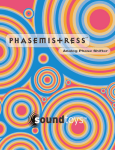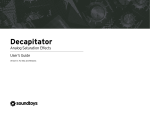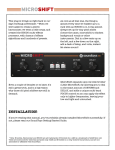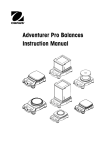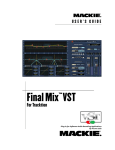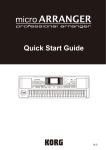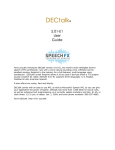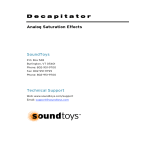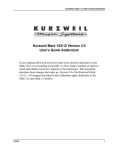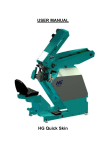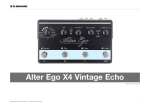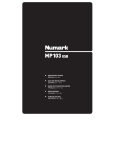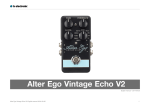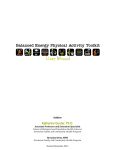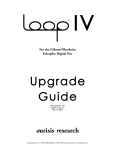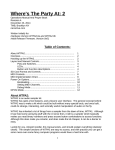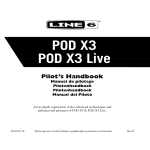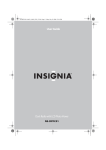Download EchoBoy 1.0 Manual
Transcript
C O N T E N T S C O N T E N T S 2 I N T R O 5 THANKS! A Delayed History and EchoBoy What and Who is SoundToys Anyway? GETTING STARTED System Requirements Installing EchoBoy Registration ECHOBOY BASICS Knobs Toggle Switches LED Displays Using EchoBoy Within Pro Tools 5 5 8 10 10 10 11 13 13 14 14 16 Real Time Processing (TDM or RTAS) Non-Real Time Processing (AudioSuite) Echo Boy Mono vs. Stereo Operation 16 17 17 Standard Pro Tools Controls 19 The EchoBoy Preset Library Compare Button Bypass Optimizing CPU Usage EchoBoy Controls Echo Styles (or making EchoBoy sound like your favorite echo) Echo Mode Input and Output Level Mix Feedback Saturation HighCut Echo Time Prime Number Switch Tempo Control Groove - Shuffle & Swing Feel - Rushin & Draggin The Tweak Button Echo Modes in Depth Single Echo Single Echo Tweak Menu Accent Width L/R Offset Dual Echo 19 20 20 20 22 22 24 25 26 26 27 27 27 29 29 30 31 31 32 32 32 33 33 34 34 Dual Echo Tweak Accent 1 and 2 Feedback Mix Feedback Balance Ping-Pong Echo Ping-Pong Echo Tweak Rhythm Echo Basics Rhythm Knob Repeats Knob Feedback Shape Knob Creating Custom Rhythm Patterns The “One” Echo Saving Echo Patterns Rhythm Echo Tweak Rhythm Length Rhythm Grid MAXING OUT THE DELAY! Accent Warp Width Pan Menu L/R Offset Style Edit EQ Freq Gain Decay EQ Res Saturation Diffusion Size Loop / Post Switch Wobble Wobble Rate Wobble Shape Sync Automating Parameters Summary Appendix A MIDI Sync With Pro Tools Version 5.x and earlier F I N A L P A G E Getting Help The SoundToys Product Line FilterFreak™ PhaseMistress™ 35 35 35 36 36 37 38 38 39 40 40 40 41 43 44 44 45 45 46 46 46 46 47 47 48 48 48 49 49 50 51 51 52 52 52 53 53 53 55 58 59 59 61 61 61 61 61 EchoBoy™ Tremolator™ PurePitch™ PitchDoctor™ Speed™ SoundBlender™ Coming Soon Decapitator™ PanMan™ FlangeThing™ Trademark Info 62 62 62 62 62 62 62 62 63 63 63 I N T R O THANKS! First off we want to say a big THANK YOU for your purchase of Echo Boy. We know there are an awful lot of plug-ins for you to choose from and we are truly grateful that you have chosen to spend your hard earned scratch (old school for cash) on our product. We take a lot of pride in our work and we sincerely hope that you find EchoBoy inspirational and musically useful. We’d also like to thank all the people that helped in the development of EchoBoy and the whole new SoundToys line of plug-ins: Wendy Letven for her amazing design work on the SoundToys logo, all the SoundToys packaging, and much more. Andrew Schlesinger for all of his help from the very start of the SoundToys concept from product names, design ideas, and presets, to his witty and useful contributions to this user guide and other sage advice. ––– The SoundToys Crew A Delayed History and EchoBoy So why EchoBoy? Simple – delay and echo are the oldest and most commonly used effects in the history of modern recording. Think about that classic double tracked effect on Elvis’ voice, the slap echo in 60’s surf music, those cheesy 50’s sci-fi movie sound tracks, Pink Floyd, The Beatles etc. They all used delay and echo extensively, as has most of the music recorded in the last 30 or 40 years. Echo and delay effects are truly essential to the modern music maker. In the early days all delay effects were based on some type of tape delay. Studios would often have a number of top quality tape machines attached to variable speed controls to be used as a delay device. The signal was fed to the input of the machine and the output of the tape was monitored off the playback head. The space between the record head and the playback head along with the speed of the tape determined the delay time. Slow the tape down and the time it took for the signal to get on to the tape and then be picked up by the playback head increased and thus the delay time increased. Speed the tape up and the opposite happened, the delay time got shorter. This provided early engineers with the ability to create variable length, short “slap back” delays. If you took the output of the playback head and fed it back into the input of the tape machine via a mixer you were able to create repeating delays and echoes. The speed of the tape machine determined the delay time and the amount of the tape output fed back into the input determined the number of repeats in the echo. When you shove a lot of signal onto analog tape the signal has a tendency to saturate and impart a very natural compression that is fat, warm and crunchy. In addition to the compression tape also adds a very characteristic type of distortion that is pleasing to the ear. This is especially true in the upper frequencies and bottom end. It’s kind of like that “loudness” control on a cheap stereo; hype the high and low end except for with tape it’s sounds really full, rich, punchy, crunchy, fat, phatt and all around great. With tape being a fully analog and non-linear medium, the sound of the echo would change quite drastically depending on how hard you “hit” the tape, how fast or slow the tape was moving, any EQ in the audio path etc. In addition, the sound of the individual repeats would also change drastically each time they were fed back from the playback head with increasing amount of distortion, noise, wobble from the tape machine and loss of high end. They did not sound “natural” but they sure sounded GOOD! In fact one of the things engineers still drool over is the sound of a high quality tape machine being hit hard with gobs of hot signal and used as a delay. This is especially true for vocals with that classic “vocal slap” being one of the most common tricks of the trade. As technology progressed self contained tape echo machines like the original tube Echoplex, then the transistor Echoplex appeared along with other tape echo devices like the WEM Copycat, Roland RE-201 Space Echo and the like. There were also “platter” devices like the Binson Echorec that recorded signal to a magnetic spinning disc that had a variable playback speed and head. All of these tape-based units provided a warm, fully analog sound in a relatively compact unit with integrated control of echo time, feedback, mixing and sometime EQ. In addition, some units provided more that on playback head allowing for various types of echo patterns. A real boon the individual musician and used extensively on both studio an stage. Fast forward to the late 70s and solid state echo devices started to appear based on what are known as “bucket brigade” analog delay chips. These chips would grab a tiny piece of analog audio (no digital conversion here) and move the snippet of sound from one “bucket” in the chip to the next at a particular rate. Put a number of these chips together with and input control, feedback and mixing (along with a clock and bunch of other circuits) and analog delays were born. The problem, or great thing about analog delays (depending on how you look at it) was that analog delays had in most cases severely limited bandwidth with the top end lopped off around 2k (or lower), limited low end, noise and grunge. The output of an analog delay for sure sounded a lot different than the input signal even in the top end units like the amazing Marshall Time Modulator. But these devices did not need to have their tapes changed, heads cleaned or have their motors wear out. They could be run on batteries and put into little pedals so that every Tom, Dick and David Gilmore could have multiple echoes at their feet. A few higher end units were made like the previously mentioned Marshall unit and the MXR Flanger Doubler, which became staples in studios for a short period of time. As mentioned they had some funky side effects but as they were analog they still sounded cool and had real character. Other classic analog delays like the Electro-Harmonix Deluxe Memory Man (think Andy Summers of the Police), MXR Analog Delay and the up and coming Boss and Ibanez units provided instrumentalists individual control over their delay sound in compact analog delay pedals. To this day there are still many manufacturers making analog delay devices for their characteristic sound, limited frequency response and less than crispy frequency response. They provide great echo that is warm and dull and are found all over top end guitar pedal boards. Next came the digital revolution and everything changed. Digital delays were all the rage with every manufacturer and their uncle making a digital delay device. Some sounded REALLY bad and had a really brittle, grainy sound. However others like the Lexicon Prime Time, PCM 41 / 42 sounded amazing and are still in high demand for the quality and character of the sound. The sound of these units was not exactly true to life. In fact they had quite a bit of compression and pre/de-emphasis that altered the sound of the signal but they provided some of the best sounding, warm (again), clear and full sounding delays that money could buy. Other units from TC, AMS in particular were also quite popular but they tended to have a more “high fidelity” sound. You’ll still find all of these units all over top studios. As for the creating good sounding delay, it is commonly accepted that echoes sound “better” when the repeat does NOT sound exactly like the input signal. Of course there are times when you DO want the delay to sound exactly like the input but in many cases the best sounding effect is when there are analog-like anomalies in the delay and echo along with limited frequency response. This is especially true on things like vocals and to this day many top artists still use tape slap or specific delay devices like the PCM 42 each of which have a less than linear or flat response. But the bottom line is they just SOUND really good. Which brings us to EchoBoy. EchoBoy is NOT your cousins delay device. EchoBoy (we hope) is likely to become one of these coveted delay devices that stand the test of time if not for its flexibility and coolness then at the very least for its SOUND! Bottom line is we have taken incredible pains and gone to great lengths to provide you with a delay/echo device that can really NAIL all those classic and great delay sounds; all in the form of a simple to use (mostly!) Pro Tools plug in. EchoBoy provides the necessary controls and parameters to emulate virtually any classic or contemporary delay device. Its main goal was to provide you with EXCEPTIONAL and versatile sound: one that is truly musical, harmonically rich and with real character. Though it can do that “input-sounds-like-output” thing, it excels at providing an incredibly wide range of unique and “analog” sounding delays, each with a unique and palpable character. It has a ton of controls that allow you to carefully interject the kind of anomalies that were inherent in tape and analog devices. You can get as tame or as wild as you want and the Rhythm Mode provides for some truly new approaches to multi-tap delays. So we proudly and humbly offer you our latest creation: EchoBoy. As Sun Ra once said; “Space is the place” and EchoBoy will likely take you to spaces and places that you have not gone before. And with all Sound Toys units, EchoBoy provides “Audio with Attitude”. Enjoy! What and Who is SoundToys Anyway? If you already own one of our other products like FilterFreak, PhaseMistress, Crystallizer, or Tremolator, you can skip this section but if not, read on to find out who we are and what we do! So what the heck is "SoundToys" anyway? SoundToys is a concept, a vision, a new line of totally cool, sonically superior audio FX plug-in devices designed to set a new standard in regards to plug in processing and sound. And, it’s our new company name. You see all of us at SoundToys (formerly Wave Mechanics) are a bunch of audio geeks that thirst for new ways to manipulate and mangle sound that are innovative, unique, and with sound quality that is in a class all its own. While everyone and their grandmother is modeling older gear these days, we are busy wracking our collective brains to develop NEW devices that are truly inventive and will stand the test of time – the kind of things you’d take with you to a desert island. Just so you know, we are the guys that were responsible for designing such groundbreaking and industry standard products as the Eventide¨ H-3000, DSP-4000, and the Wave Mechanics UltraTools line of plug-ins for Pro Tools TDM. Our DSP algorithms can even be found in such high-end studio gear as the TC Electronics Fireworx, G-Force, and G-Major processors, and more. Our approach in developing the SoundToys series of Pro Tools plug-ins is to create a series of dedicated processors that provide the absolute best possible sound quality, flexibility and creative sound manipulation in the wonderful world of digital, but that also possess that truly analog character and vibe. G E T T I N G S T A R T E D System Requirements EchoBoy is software plug-in for the Digidesign Pro Tools system. You’ll need to have at least one decent Macintosh computer (G4 or better. Faster is always better) running OS X or later and of course you’ll need a copy of Pro Tools version 6.0 or later. EchoBoy support the TDM, RTAS and AudioSuite plug-in formats. In order to use the TDM format, you must have a Pro Tools HD or HD Accel system. If you own a Pro Tools Mix system, you can still use EchoBoy, but you will have to use it in RTAS format. You’ll also need one of those little "iLok" hardware keys. It’s a small blue plastic key that looks like this: If you don’t have an iLok we’ll be happy to sell you one at a modest price or you can purchase one from Digidesign or your favorite Pro Tools dealer. Installing EchoBoy Installing EchoBoy is really pretty easy. The procedure is slightly different depending on whether you have purchased the download version of EchoBoy, or the packaged non-download version. Packaged Version First, make sure that you have your iLok hardware key connected to your computer, and that you have the EchoBoy license card handy. Once you’re ready, simply pop the EchoBoy CD into your computer’s CD-ROM drive and when the CD icon appears on your screen double-click the EchoBoy installer program to start the process. Follow any instructions included in the installer and at the end of the installation process you will be prompted to ‘authorize’ EchoBoy. To do this, carefully detach the license chip from the license card, and insert the chip into the slot in the rear of your iLok when prompted to do so by the installation program. Download Version When you purchase the download version of EchoBoy, you should have been instructed to download the EchoBoy software installer from our web site. If you haven’t done so already, please download it now. You will have also received an EchoBoy iLok ‘asset’ from us, deposited to your iLok.com account. This iLok asset is what we use to unlock EchoBoy for paying customers (like you! ) In order to use EchoBoy, you will need to transfer the EchoBoy asset from your iLok.com account into your iLok hardware key. If you haven’t already done this, go to www.iLok.com, and follow the instructions on that web site for transferring the asset into your hardware key. Now, run the EchoBoy installer program. Where We Put Everything Once installed, a copy of the EchoBoyª plug-in will be located in your Digidesign plug-ins folder along with a cool set of EchoBoy presets. Finally, a SoundToys folder will be created in your Applications folder. The SoundToys folder contains this manual, as well as other useful documentation and tools that you can read or ignore depending on your level of patience or interest in reading babbling things like this manual. Registration If you purchased the packaged version of EchoBoy, please register your product by going to http://www.soundtoys.com/register. If you purchased the download version from the SoundToys web site, there is no need to register, as we have already done that for you. For registration, you can find the serial number for EchoBoy on the black plastic registration card inside the EchoBoy package. We also suggest you keep this card in case in a safe place, along with the original CD. We also strongly recommend that you go to http://www.iLok.com, set up an iLok.com account, and register your iLok. By registering your iLok, we can better support you in the rare case that your iLok malfunctions, or you have some other problem with your EchoBoy authorization. E C H O B O Y B A S I C S Since you would probably not be reading this unless you own a Pro Tools system we kind of take it for granted that you have at LEAST a basic working knowledge of your computer and of Pro Tools. If you don’t, we strongly suggest you make yourself a strong cup of coffee (or two), get a comfortable chair and familiarize yourself with the ins and outs of your Pro Tools system before delving too much further into EchoBoy. Digidesign is really nice and provides lots of manuals for your reading pleasure! Knobs You can use a mouse to control all of the knobs in EchoBoy and they all work in the same way: To turn a knob up, (to the right, clockwise etc), click on the knob with your mouse and drag the cursor to the right or slide the cursor up (towards the ceiling). To turn a knob down, (to the left, counter-clockwise), click on the knob with the mouse and drag the cursor to the left or down (towards the floor). "Mousing" around in a circle doesn’t really work; you’ll just get frustrated and or dizzy, neither of which is a lot of fun. Jumping to a Value using Text Markings Some knobs have text markings showing minimum, maximum, or other values. Clicking on one of these text markings will automatically move the knob directly to that value. Returning a Knob to its Default Value To return to the knobs "default value", simply hold down the option key and click on the knob. This will automatically move the knob back to its default value. Viewing a Knob’s Exact Value To view the exact numerical value of a knob simply hold down the control key and click on the knob. To see the knob’s title, hold down control and click on the knob a second time. Adjusting a Knob with Fine Control To get finer control over knob values, hold down the apple [ ] key while dragging the mouse. Toggle Switches In an effort to provide the feeling of real analog gear our toggle switches "switch" when clicked. To change the "state" of a toggle switch (like the analog/digital control), simply click on the switch it will change from where it was to the "other" setting. Click again to change it back. Really simple! LED Displays LED displays on EchoBoy work in a couple of ways: Nudge Buttons Most text readouts also include a pair of nudge buttons next to the display. Clicking on the upper button will increase the value by one and clicking once on lower button will decrease the value by one. This is useful for tweaking a value by small steps. Numerical Readouts & Entering Values from the Keyboard For numerical readouts, (like BPM), you can enter exact values right from your computer keyboard. Clicking on the LED display highlights the field and makes it "live". Once highlighted, you can enter a new value via the computer keyboard. Press, "Return" to submit the value and deselect the field. You can also click & drag the cursor to change the value. Simply click on the value and drag the cursor up to increase the value or down to decrease the value, similar to using a knob control. Press, "Return" to submit the new value and deselect the field. Pop-Up Menus & Changing Values: For most text-based readouts (meaning things that aren’t a number), like Echo Style, etc., clicking on the readout with the mouse will display a popup menu. To change a value in the popup, hold down the mouse button and drag to select the desired value and let go. The selected entry will show up in the field, or a new pop-up window may appear depending on what you have selected. U s i n g E c h o B o y W i t h i n P r o T o o l s Now that you know how to use knobs and pop-up menus, it’s time to actually use EchoBoy within Pro Tools. EchoBoy is available to process your audio in two different ways: Real-Time, or Non Real-time. Real Time Processing (TDM or RTAS) As a real-time plug-in, EchoBoy works a lot like a real hardware echo device. Whatever sound goes into EchoBoy, comes out with an echo on it, and you can hear it as it is happening (in real time!). To use EchoBoy in this way, you must first select EchoBoy as one of the insert devices within Pro Tools, by clicking on the inserts button on a track. You can do this either from the edit or mix window in Pro Tools. From the inserts pop up, select EchoBoy as shown in the next graphic... You can insert as many versions of EchoBoy as you’d like, just keep in mind that each one gobbles up certain amount of DSP power. If you are running the RTAS version, the CPU cycles can make your computer start to sweat in terms of what’s left over for other tasks. Non-Real Time Processing (AudioSuite) If you want to save DSP power, EchoBoy can also be used to process a specific region of audio destructively. This is done in Pro Tools using the AudioSuite version of EchoBoy. To do this, first select the region of audio you’d like to process from the Edit window of Pro Tools. Then choose EchoBoy from the AudioSuite menu of Pro Tools. Hit the process button to process the selected region with EchoBoy and to write the result back to disk. To hear the effect before committing to disk, click on the preview button. Echo Boy Mono vs. Stereo Operation EchoBoy provides both Mono and Stereo plug-ins for use on mono or stereo track inserts or busses. If you are using EchoBoy on a stereo insert (or processing a stereo region with AudioSuite), the processing will be TRUE stereo. This means that if you use EchoBoy in a stereo mix bus what ever is coming out of the left side will have a delayed version appear in the same location as the input signal with the same being true for the right side, middle etc. The delays will appear where ever the input signal appears in the stereo mix. The only times this is NOT true is in Ping-Pong and Rhythm Modes. In these modes the left and right channels are summed to feed the input of the delay. The output of course remains in stereo so you can hear the ping pong, cross channel delays etc. Otherwise the ping-pong effect would be lost, as these require that the input be mono and the output be stereo. For mono inserts, you have the option of using a mono output or stereo output version (monostereo mode). We highly recommend that you check out the mono-stereo version if you are working with mono tracks. This can be used to create a beautifully wide stereo image. S t a n d a r d P r o T o o l s C o n t r o l s EchoBoy is designed to be very integrated with Pro Tools, supporting all of the “standard’ Pro Tools plug-in features and controls including parameter automation, MIDI control, etc. Access to these functions can be found in the gray bar that Pro Tools attaches to the top of EchoBoy. The display below shows the real-time version of EchoBoy. When using the AudioSuite version, an additional gray bar will appear on the bottom with buttons to control previewing and processing. The EchoBoy Preset Library For your immediate listening pleasure and for those who just can’t wait, we’ve included a bunch of carefully crafted, creative, cool presets with EchoBoy. You might want to check these out, as they not only provide a good example of the various types of effects that can be achieved with EchoBoy, but one of them just might be the ticket you need for your latest hit record or production. They also provide a great starting point for you to tweak and mangle to your hearts content. Besides, we spent a whole bunch of time making them so you might as well give them a spin. Loading a Preset To view and load a EchoBoy preset, simply click on the Settings Librarian button located in the standard Pro Tools plug-in controls area, located at the top of the plug-in window, located in Pro tools, located on your computer, located in your, oops, sorry! And as you would expect, for more info on the Pro Tools Settings Librarian, please read the Pro Tools manual. Saving a Preset Saving a preset is just as simple. Click on the small button to the left of the preset name and choose “Save’ to update the current preset, or “Save As’ to create a new preset. Compare Button The compare button (often called the compare “light’ by Pro Tools pros) is a great way to audition the effect of any changes you’ve made to one of the EchoBoy presets. As soon as you change any parameter in EchoBoy, the compare light will come on. Click on the compare light to toggle between the original preset and your current changes. Bypass One of the more useful features on any plug-in is the Bypass button. Click on this to bypass the effect of EchoBoy. This also recovers any CPU cycles being used by EchoBoy. Optimizing CPU Usage If you are running the TDM version, you don’t have much to worry about. The specialized DSP chips in your TDM system do all of the heavy processing for EchoBoy. However, if you are running the RTAS version of EchoBoy it will use your computer’s processor to do its audio processing. Because of its advanced DSP algorithms, EchoBoy can put a pretty heavy load on your processor. Here are some tips to reduce the processing: • If you’re running multiple tracks through the same effect, use EchoBoy on an aux track and use sends to route the audio through EchoBoy. • Commit your effect to disk by using AudioSuite, or, by bouncing to disk E c h o B o y C o n t r o l s Echo Styles (or making EchoBoy sound like your favorite echo) EchoBoy’s unique “Echo Styles” control makes it easy to radically change the echo tone quality to suit your taste and musical style. We’ve built in a wide range of different echo sounds, from the subtle warmth of high-end studio tape echo, to the lo-fi warbly sound of classic tape echo boxes like the Echoplex and Roland Space Echo. To change the Echo Style, simple click on the Echo Style pop-up control. Here’s a quick run-down of the built-in styles: Master Tape Subtle tape compression and distortion, modeled after the ATR102 we have in our lab, running at 30 ips. Studio Tape Subtle distortion and high frequency compression modeled after the ATR-102 running at 15 ips. EchoPlex One of the true classics. This style’s modeled after the EP-3 solid state tape echo. Space Echo One of our favorites, modeled after the Roland RE-201 Space Echo we have here in the lab. Tube Tape Modeled after a modern tape echo. Lot’s of high mid and distortion. Cheap Tape A SoundToys original a bright compressed tapey effect. Memory Man Warm low-bandwidth chorus echo, modeled after the ElectroHarmonix Memory Man delay pedal. DM-2 THE guitar echo sound, modeled after the classic Boss DM-2 guitar pedal. TelRay The ultra-dark liquid sound of vintage oil can echo. Binsonette Another SoundToys original, a wonderful warbly, compressed echo sound, perfect for guitar and keys. Telephone The narrowband sound of telephone. This is great on vocals. AM Radio Models the compressed medium bandwidth of AM radio. FM Radio Ultra-compressed and loud. Shortwave Exaggerated long-distance radio sound. Really cool effect on vocals. Transmitter Kind of like a CB radio – distorted and resonant mids. Digital Delay Clean Digital. Analog Delay Warm and lightly distorted – reminiscent of old rack mount analog delay processors. Digital Chorus The 80’s chorus sound. Really nice on guitar or vocals. Analog Chorus Warm chorus, great on anything CE-1 Chorus Beautiful classic guitar chorus, modeled after the Boss CE-1 rare vintage chorus pedal. Vibrato True ‘pitch’ vibrato. Great on keys and guitar. Saturated Exaggerated tape distortion. Nice on vocals or drums. Fat Super warm distorted echos which sound great on guitar. Distressed Compressed and distorted echos. Limited This one’s got a built-in limiter. Great for hyper-feedback settings. Distorted Lot’s of distortion. Queeked Cool multi-band compression effect. Ambient Distortion and diffusion. Great for long feedback loops and solo instruments Diffused Great for creating ambient reverb-like echo effects. Splattered A cool sort of verby reflection effect. Verbed A cheap ‘verb’ after the echo. As if the above styles weren’t enough, we’ve also given you the power to create your own Echo Styles. To access the “guts” of EchoBoy, click on the Style Edit button. To find out more about this, go to the “Creating Your Own Echo Styles” section at the end of this manual. *Any trademarks of other manufacturers are the property of their respective owners, which are in no way associated or affiliated with SoundToys. These trademarks are used only for historical reference or to identify products whose sounds or tone were studied in the “Echo Style” development of EchoBoy. Echo Mode EchoBoy can function in four distinctly different modes: Single, Dual, Ping-Pong, and Rhythm modes. Each of these is a different algorithm, with differing numbers of delay outputs and signal routing. The Echo Mode control switches between these four basic algorithms. As you change the Mode you will notice that the controls on the left side of the front panel will change to display the parameters that are needed for the particular Mode. In addition, the controls located under the Tweak menu will also change depending on the Mode selected. Let’s look at the four Modes individually... Single Echo EchoBoy’s Single Echo mode is the most simple, and is also most similar to the “classic” echo effects. Choose an Echo Style, dial in your echo time, turn up the feedback, and voila! When used on a stereo channel, a true stereo echo is provided, with separate signal paths for left and right channels. When inserted into a mono channel, a pseudo-stereo output is created. Dual Echo Dual Echo mode is just like Single Echo mode, except that there are now two independent echo channels, with separate Echo Time controls for the left and right channels. When used on a stereo channel, left and right inputs feed the left and right echo channels. When inserted on a mono channel, the mono input feeds both echo channels. Ping-Pong Echo Ping-Pong mode is very similar to Dual Mode except for one thing – the input is fed to the left channel, which then feeds the right channel for the classic “ping-pong” effect. As the name implies, Ping-Pong bounces the delay signal between the left and right channels with each successive echo repeat. With the feedback control set to zero, you will hear two repeats. The first repeat will appear in the left “Ping” channel and the second repeat will always appear on the right “Pong” channel. As you add feedback, you will get more repeats, with successive repeats bouncing back and forth from left to right. The input to the Ping-Pong mode is always mono - when used on a stereo channel, the left and right inputs are mixed together to feed the ping-pong echo algorithm. Rhythm Echo Rhythm mode has one delay line, with up to sixteen individual outputs (or “delay taps”). This type of configuration is commonly known as a “Multi-Tap” delay, and is found in rack-mount delay units like Eventide’s H3000 or the Lexicon PCM-72. In Rhythm mode, each output can be programmed with independent delay times and levels. This mode makes use of the SoundToys rhythm pattern library – patterns may be saved and recalled and shared amongst any SoundToys plug-in. Rhythm mode produces a stereo output, and has a variety of panning shapes that are controlled by the Pan Shape tweak parameter. The input to this mode is always mono - when used on a stereo channel, the left and right inputs are mixed together to feed the multi-tap delay. Input and Output Level One of the cool things about EchoBoy and all Sound Toys plug-ins is the Input and Output section. Instead of keeping these controls tame, the Input and Output controls allow you to vary the tone of the input signal being sent to the echo circuit. You can keep it nice and clean or make it dirty and messy. These controls were designed to replicate the way true analog input sections respond on “physical” analog or real gear. (and they will sound very different depending on the setting of the Echo Style). The LEDs beneath the Input and Output knobs provide visual display of the input and output signal levels. The yellow LED indicates that the signal is 6dB below clipping. The red LED indicates maximum signal level, and possible clipping or distortion, which may or may not sound so good depending on the current Echo Style, and what your ears like to hear. It’s important to note that the Input and Output level only affects the echo signal and leaves the dry signal unchanged. This approach may be slightly different than that of some other plug-ins and we found this implementation to work best for EchoBoy. Mix The Mix knob defines the mix balance of dry signal to delayed signal. At 12 o’clock the mix balance is 50/50. As the control is increased beyond 12 o’ clock the level of dry signal is decreased until you have just delay. If you are using EchoBoy in line you’ll likely want to use the mix to define the balance of dry to delay. If you are using Echo Boy in a mix bus you will likely want to set the mix to 100% wet and use the send return levels to define mix of the delayed signal. The Mix control provides another means of controlling the relative level of effect to dry. This allows you to balance individual delay presets and even out possible amplitude anomalies. As they say, add Echo and Mix to taste! Feedback The Feedback knob allows you to feed a variable amount of the delay back into the input to create multiple repeating echoes. Increasing the Feedback increases the number of repeats. Depending on the Style selected this allows you to create tape-like echoes that decay over time, multiple repeats and unique rhythmic effects based on the Echo Mode selected. Note that setting the Feedback value to high or near maximum can easily drive EchoBoy into “runaway” mode. At higher settings thing can get pretty hairy very quickly. The echoes can get really loud and distorted and may or may not sound so great. So please be careful when turning up the Feedback knob! Saturation The Saturation control provides a quick and easy means of imparting a tube or tape-like compression, emphasis and subtle distortion into the delay signal. Saturation is a unique parameter that allows EchoBoy to emulate many types of analog devices and specifically different types of tape-based delays both high and low end. The exact effect of the Saturation control will depend on the current Echo Style setting. In some cases, this effect may seem fairly subtle. For example, when using the “Studio Tape” echo style, increasing amounts of saturation will add odd harmonic distortion in the low and mid-range, and will cause a high frequency compression effect. This effect is especially nice on vocals, adding a bit of automatic ‘de-essing’ on the echo during louder vocal passages. Or, when the style is set to “Limited”, the saturation control functions more like a limiter threshold, and will add increasing amounts of a very cool pumping limiter effect. HighCut The High Cut knob works in a similar manner as the Saturation knob in that its effect will depend on the currently selected Echo Style. The front panel High Cut knob provides a quick and easy method of “darkening” the delay. This can make the delays more echo-like and help them blend better with the original signal. Most analog delays and tape echoes have a certain amount of high frequency roll off and this front panel control allows you to create that kind of effect. It’s important to keep in mind that the effect of the HighCut control depends on the Echo Style. Echo Time The Echo Time knob is used to control the amount of time between your original sound and the echo output, and also the amount of time between echo ‘repeats’. Echo Time can be adjusted in several different ways, controlled by the buttons under the Echo Time knob labeled “Time”, “Note”, “Dot” and “Trip”. In rhythm mode there is one additional button labeled “Pattern”. Time Button Pressing the “Time” button allows you to set the delay time in millisecond values using the knob or the LED menu, like old-school delay units. The sound in this mode is also old-school analog – when you wank on the knob, the pitch will change just like an old analog delay box, and unlike many modern units that glitch, burp and crinkle with this kind of action. For the less scientifically inclined of you out there, a millisecond is one one-thousandth of a second (or a very, very short time!). 500 milliseconds is half of a second, which is 1 beat at 120 BPM. Very short delay times (0 to 10 milliseconds) can produce some really cool flanging effects, and slightly longer times (10-50 milliseconds) can be used to produce chorus and doubling effects. Slapback echoes are usually in the 100-200 millisecond range. The maximum echo time depends on the specific Echo Mode and whether you are running EchoBoy in TDM, RTAS, or AudioSuite format. Note, Dot, and Trip Buttons Pressing any of these buttons changes the delay display and control from millisecond values to Note values. This is a very cool and musical way to adjust echo time. Just dial in the note value you want to hear – 16th note, 1/8th note, 1/4 note, etc. and EchoBoy will lock right in to your groove. You can also choose dotted or triplet versions of musical note values by using the “Dot” and “Trip” buttons. Make sure to set the right tempo using the Tempo control – more on that later… When programming Echo Time using one of the Note settings, EchoBoy will smoothly crossfade to any new note values. This is a little extra something that makes EchoBoy unique and a pleasure to use (and also extremely useful when automating echo rhythm changes in the middle of your song). Patt Button In Rhythm Mode, the “Patt” or Pattern button lets you recall or save a customized rhythm pattern. SoundToys rhythm patterns are shared between any SoundToys plug-in, so if you created a cool rhythm in FilterFreak, you can now use that to program rhythmic echo repeats in EchoBoy. Remember that the setting of the Tempo, Groove and Feel controls will all affect the feel and sync of the delays when any of these note values or rhythm patterns are selected and used. Prime Number Switch When the Prime Numbers switch is in the up position delay repeats are slightly altered in time in a very special way to minimize resonance effects. This is most noticeable in ‘dual’ mode or ‘rhythm’ mode. This is especially useful when you are using short delay times with feedback, when chorusing, flanging or creating reverb-like effects. It keeps the repeating echoes from building up resonance that often occurs when every repeat is at exactly the same time interval. Tempo Control When programming the Echo Time in musical note values, EchoBoy needs to know what tempo your song is at so that it can compute the exact amount of echo time needed to keep things all in sync (remember when you had to do that all math by hand – eek!) There are three ways to tell EchoBoy what tempo your song is playing at – “tapping” it, entering the exact BPM value, or syncing to MIDI tempo, Tapping the Tempo Simply place the cursor over the Tempo button and click the mouse in time with the track. You will notice that the LED readout will change as you tap the button and display the tapped tempo in BPM. To change the tempo to a new value, simply tap the button a couple of times and a new value will be input. Tap tempo is really useful and allows you to adjust the delay time to be in concert with the tempo of a track. It will not be EXACTLY in sync but will get you into the ballpark. Entering a BPM Value BPM stands for Beats Per Minute, and is the standard way of specifying the tempo of a piece of music. If you know the BPM of your track, you can enter it by clicking in the LED tempo display, typing a value between 30 and 300 and pressing the Return or Enter key. This will set the tempo to the new value and set the delay times accordingly. Syncing to MIDI The Midi switch allows you to quickly lock EchoBoy to Pro Tools Midi clock. If you have set the tempo in your session correctly, simply click on the MIDI switch so that it is in the “Up” position with the red LED illuminated. The tempo menu will read out the tempo of the incoming MIDI clock and the Tap Tempo button will be disabled, as EchoBoy will be locked to the incoming signal. If you flip the switch off EchoBoy will no longer be synced to midi clock and the tap tempo will again become active. Note: The MIDI Sync feature requires version 6.0 of Pro Tools or later. If you are running an earlier version, see Appendix A for more information. Please note that Tempo ONLY works when the delay time is programmed in note values (by selecting the Note, Dot, or Trip buttons) and will not have any affect when the delay time is set in milliseconds. Groove - Shuffle & Swing The Groove knob changes the rhythmic character of EchoBoy, adding a swing or shuffle effect to the echo repeats. This gets rid of the mechanical, right-on-the-beat feel you get with a “standard” delay. This is pretty unique and really darned nice. To really hear the effect of the Groove knob, select a note value like 1/8th, and turn up the feedback so you get lots of repeats. Play a couple of staccato notes in time with the tune and then twist the knob one way then the other and listen to the results. It should become clear in two shakes of a cows tail what is going on and if all is right you’ll be groovin’ in no time! By default, the Groove knob is set straight up at 12 o’clock, and the delays will be heard as normal with no Shuffle or Swing feel and successive delay repeats will fall exactly “on” the beat. To get a shuffle feel, turn the knob counter counter-clockwise. The echoes will now have a laid-back rhythmic feel, with every other repeat getting delayed a bit MORE, giving you a kind of syncopated triplet feel. To get a swing feel turn the knob clockwise. The echoes will now have a ‘pushed’ feel, with every other repeat getting delayed a bit LESS. Feel - Rushin & Draggin EchoBoy can slow you down when you feel rushed or pep you up when you’ve had a late night out. Feel...it’s that “magic” that keeps music from being metronomic, cold and sterile. Simply put the Feel knob slides the whole delay output of EchoBoy around in relation to the beat, and helps to get the echo “in the pocket” where it sounds best. Draggin’ By turning the control counter clockwise towards “Draggin” an increasing amount of delay is imparted on both left and right channels before the echo signal, kind of like pre-delay in reverb. This kind of “slides” the echo behind the downbeat based on the amount of Draggin’ you dial in. As the control is increased an increasing amount of delay is added and the delay/ echoes will fall further and further behind the downbeat. This can be really useful in both moving the delays out of the downbeats as well as helping to move them into the “pocket” when the music is not highly metronomic. Rushin’ Rushin’ is the opposite of Draggin’. Instead of sliding the delays behind the beat it actually moves them ahead of the beat. This is kind of like adding “negative pre-delay”. As you turn the knob further towards the maximum value the delay will be move increasingly ahead of the beat. Again this helps you move the delays into the “other” pocket. You’ll probably find the Rushin’ control especially useful for your next hit Polka or Marching Band hit! The Tweak Button Pressing the “Tweak” button opens a pop-up menu providing access to an additional set of parameters. We’ve ‘hidden’ these parameters because we didn’t want to over-complicate the control panel. But we know that many of our Pro users really want to get in and control every aspect of their sound. The parameters included in the Tweak menu change based on the current Echo Mode. The specifics of these parameters will be explained in the next section, “Echo Modes in Depth”. E c h o M o d e s i n D e p t h Single Echo Single mode is our favorite way of using EchoBoy – simple to use, easy to understand, and just sounds great. There’s really not much more to explain here, except for the tweak menu… Single Echo Tweak Menu In Single Echo Mode, the tweak menu looks like this: And includes these parameters: Accent, Width and L/R Offset. These affect the delay in the following ways... Accent The Accent knob does for amplitude what the Groove knob does for timing. By turning up the Accent, delay repeats will alternate between louder and softer, producing a more dynamic and musical echo effect. To hear the effect of the Accent control, turn up the feedback so that you can hear lots of repeats, and choose a note value like 1/8th or 1/16th. The Accent knob is bipolar, so that at 12 o’clock or straight up, the Accent knob has no effect. As you turn the Accent knob to the right, or clockwise, you will notice that the volume of each repeat will alternate between loud and soft. This will emphasize the 1st, 3rd, 5th, etc. of the echo pattern. This will produce a strongly accented musical feel. Turning the knob in the other direction, or counter-clockwise will have the opposite effect, emphasizing the ‘off-the-beat’ repeats, resulting in a more syncopated feel. In this case the 2nd, 4th, 6th, etc. will be emphasized, and the repeats that land on the beat will be quieter. This can add considerable animation and dynamics to repeating delays and is especially cool when the repeats are tempo synced and when you add shuffle or swing with the Groove control. Width The Width parameter controls the stereo spread of EchoBoy’s output. When set to its minimum value or off, the delay time for the left and right channel is exactly the same and the delay (with a mono input) will appear panned center in the stereo field. As the Width control is turned up, the stereo image will get wider and wider. As this width control is turned past the 3 o’clock position, “out of phase” information is used that can move the delay signal outside the speakers in a pseudo-super-stereo spread. The stereo effect created by EchoBoy is a function of the L/R Offset parameter described below, and the Diffusion and Wobble parameters, which can be found on the Style Edit page. Suffice it to say that different Echo Styles will have different flavors of stereo imaging. Adding some Width can really fatten up the delay signal, creating a much fuller and ‘richer’ effect. L/R Offset The L/R Offset is used to control the stereo imaging of EchoBoy, by adding a small delay difference between left and right channels. This parameter is adjusted in milliseconds, and has a maximum value of 25 milliseconds. By default, this parameter is set to 8 milliseconds, which is a value that creates a nice wide stereo image. Smaller settings of this parameter will produce a tighter rhythmic feel, but may introduce some phasing effects to your sound. Larger settings will tend to produce less phasing problems, but will produce a looser rhythmic feel. In order to hear the effect the L/R offset control, the Width control (described above), must be turned up. Dual Echo Dual Echo Mode is a lot like Single Echo Mode – except that you now get two independent echo channels. The Echo 1 section controls the left channel echo, and the Echo 2 section controls the right channel echo. You can have one channel free wheeling (based on time) and NOT synced to Tempo while the other channel IS tempo-synced and set to a specific note value of your choosing. This allows you to create all sorts of different creative delay combinations. Keep in mind that the other controls; Feedback, High Cut, Saturation and the like DO affect both channels the same, regardless of whether the input is mono or stereo. Dual Echo Tweak Pressing the Tweak button while in Dual Echo mode launches the Tweak menu showing the associated tweak parameters for Dual mode. You’ll notice that there are a few additional parameters but that a few are the same as in Single Echo Mode. Here’s a rundown of what’s new: Accent 1 and 2 You’ll notice that instead of one Accent control there are now two – for each echo channel. Feedback Mix Normally, the two echo channels in Dual Echo mode are completely independent. The Feedback Mix control allows some of the output of Echo 1 to feedback into Echo2, and vice-verse. As you increase the value of the Feedback Mix knob, an increasing amount of Echo 1 will be fed into Echo 2 and an increasing amount of Echo 2 is fed into Echo 1. At the exact middle setting (12 o’clock”), equal amounts of Echo 1 and Echo 2 will be fed into both channels. This is a great way to get dense, reverb-like echo sounds. At the maximum setting, Echo 1 will get all of its feedback from Echo 2, and vice-verse. This is referred to as “cross” mixing and provides for some really unique cross-pollinated and syncopated delay sounds, depending on the settings for the two Echo channels. Keep in mind that front panel Feedback knob has to be turned up some to hear the effect of the Feedback Mix (duh!) As we have mentioned a gazillion times there is no right or wrong sound here and you should use your ears to judge what sounds best. Balance The Balance knob gives you control over the relative loudness of the Left and Right channels. Turn the knob to the left to make the left channel louder. Turn it to the right to make the Right channel louder. That’s it! Feedback Balance Turning up the Feedback knob in Dual Echo Mode will normally affect Echo 1 and Echo 2 equally. To get more feedback in the right channel, turn the Feedback Balance control to the right (clockwise). To get more feedback in the left channel, turn the knob to the left (counterclockwise). This can be especially useful when Echo 1 and Echo 2 are set to different times, as the feedback of one side may “appear” louder than the other side. This control allows you better tailor and adjust the balance and stereo image of the echo feedback. Like the Feedback Mix control, this knob will only have an effect when the front panel Feedback knob has been turned up. Ping-Pong Echo Ping-Pong mode is used to create an Echo that ‘bounces’ back and forth between the left and right output channels. The control panel is nearly identical to the Dual Echo mode, but the effect is very different. There are a couple of things to keep in mind in regards to the Ping Pong Mode... First, the initial echo will ALWAYS appear in the left “Ping” channel with the initial repeat determined by the echo time set for Ping, be it in milliseconds or Notes. The second echo will always appear in the right “Pong” channel and “when” it appears it is based on the Ping time PLUS the Pong time. Even if the Pong delay time is set SHORTER than Ping, you will always hear Ping FIRST and then Pong. As you turn up the Feedback control things can get really interesting as each successive repeat is predicated on the other side being heard. For example, say Ping is 500 ms and Pong is 250 ms. If you play a note you will hear Ping 500 ms later, Pong 750 ms later (Ping + Pong) and Ping again at 1250 ms (Ping+Pong+Ping) then Pong again at 1500 ms (Ping + Pong + Ping + Pong) and so on and so on. So the delay repeats are relative to each other with each repeat of Ping showing up in the left channel and each Pong repeat showing up in the right channel but only AFTER the other has been heard. Things can get even wilder and truly strange depending on when either Ping or Pong is set to a specific Note value with Midi sync and the Pong is set to Time in milliseconds or any combination thereof. Setting both Ping and Pong to Note values and syncing to Midi clock can provide for some fantastically rhythmic synced delays. Again keep in mind that Ping Pong is always stereo out, but that the input is always summed to Mono. This is true regardless of whether you are running on a mono or stereo insert. Ping-Pong Echo Tweak Pressing the Tweak button while in Ping-Pong Mode launches the Tweak menu showing the associated tweak parameters for Ping-Pong mode. You’ll notice that there only two parameters, Width and Balance. The Width knob works as previously described for the Single Echo mode, so the only thing new here is the Balance control. Balance The Balance knob gives you control over the relative loudness of the Left and Right channels. Turn the knob to the left to make the left channel louder. Turn it to the right to make the Right channel louder. That’s it! Rhythm Echo Rhythm Mode is, as they say, a bit different from the rest. In this mode, you can have up to SIXTEEN echo outputs (or taps), programmable in nearly any conceivable rhythm. This is kind of like having a tape echo with sixteen read heads. CRAZY! (actually, the old Roland Space Echo did have several read heads – but not sixteen.) We’ve tried to design EchoBoy’s rhythm mode so that you can get some very cool results with a minimum of knob turning and tweaking. You can quickly create echo patterns with various time bases, numbers of repeats, and envelope shapes. This is really cool (we think), but you may notice EchoBoy’s Rhythm mode might not work EXACTLY as you would expect, especially if you have used another type of multi-tap delay. Basics EchoBoy’s Rhythm Mode is a lot like a pattern-based drum machine for echo, with each ‘hit’ corresponding to a discrete echo. You can place each echo at any location on a beat grid, and once the pattern is created it, you can hit EchoBoy’s input with a short percussive sound, and EchoBoy will “play” out your echo pattern. Turn up the feedback and the whole pattern will repeat. Sync it to MIDI clock and you can generate some amazingly cool, tempo-locked delay patterns. All in all a truly amazing tool and a ton of fun. The main graphic window is the rhythm editor. This gives you a graphical view of the echo pattern, as well as a means to tweak each individual echo. Each echo is represented by a thick bright green vertical bar in the rhythm pattern window. Echoes furthest to the left will be heard first, and echoes to the right will be heard last. The volume of each echo is represented by the height of each green echo bar. Taller echoes will be louder, and shorter echoes will be quieter. The rhythm editor window represents the full length of the echo pattern – you will only hear repeats that are visible on this display. By default, this pattern is 2 beats long. To make the echo pattern longer or shorter, you can adjust the pattern length control under the ‘Tweak’ button. Rhythm Knob The Rhythm knob is used to quickly and easily set up a simple rhythmic echo pattern. This looks and works a bit like the Echo Time knob in EchoBoy’s other modes, with one important difference. In Rhythm mode, you can dial in a specific knob of repeats using the Repeats knob (instead of using Feedback). The advantage of this is that you can control both the volume level and the exact timing of each echo, giving you much more creative power. For example, to hear exactly four repeats at 1/16th note intervals, dial in a note value of 1/16th, and set the Repeats knob to 4. You will see four green bars appear on the display, one corresponding to each echo repeat. To hear more or less repeats, increase or decrease the Repeats value. And just like the other modes, selecting “Dot”, “Trip” will create an echo pattern based on dotted or triplet notes. Selecting the ‘Time’ button will create an echo pattern in milliseconds, and just like the other modes, you’ll get that cool analog pitch shift effect when adjusting delay in milliseconds. (In any of the ‘note’ modes, the echo times will instead smoothly crossfade to new values.) And to get at the real power of Rhythm mode, click on the “Patt’ button. Echoboy comes with a bunch of preset patterns, which can be easily selected by pressing the down arrow to the right of the LED menu and highlighting “Presets”. This will show you a list of the custom preset patterns as well as any user presets that have been saved at the end of the list. Scroll up or down through the list to select one of the preset patterns or use the up/down nudge buttons to scroll through and select a preset pattern. You can also create and add as many user patterns as you like. Echoboy includes a bunch of standard Bar and Note based presets with various types of Dotted and Triplet patterns that make great starting points for creating your own patterns. Please Note: As soon as you edit any tap in the Edit screen the LED menu above the edit screen will read “Custom Time” indicating that a change has been made in the pattern currently shown on the screen. Note: SoundToys rhythm patterns are shared between any SoundToys plug-in, so if you created a cool rhythm in FilterFreak, you can now use that pattern in EchoBoy’s rhythm mode. Remember that the setting of the Tempo, Groove and Feel controls will all affect the feel and sync of the delays when any of these note values or rhythm patterns are selected and used. Repeats Knob The Repeats knob defines how many individual echo repeats you will hear. You can select the number of Repeats by turning the knob or by using the nudge buttons on the left side of the LED display. If you turn the number of beats down, any echos already on the screen above the newly selected value will go away, and you will no longer hear them. Increasing the repeats knobs will cause these echoes to re-appear and to be heard. If you increase the number of taps Echoboy will automatically place a new tap at the next logical location based on the selected Grid value. Feedback The Feedback knob is used to ‘recycle’ the echo pattern. Turning it up will cause the entire rhythm pattern to repeat. Important - this is different from the Repeats knob! The Repeats knob controls how many repeats you will hear WITHIN the visible pattern. The Feedback knob controls how many times the entire pattern will be played out. Shape Knob The Shape parameter allows you to apply various amplitude shapes across all the echos on the screen, providing a quick and easy way to manipulate the echo level. The Shape knob determines how much of the selected volume shape will be applied to the taps in the pattern. The LED display and nudge buttons are used to choose which shape to apply: Decay Successive echos get progressively lower in volume moving from left to right. This is used to create a ‘natural’ echo decay pattern, and can be useful for creating reverb-like sounds. Reverse The opposite of Decay. Progressive echos get louder. This is a really cool effect, and can be used to create the classic 80’s backwards echo effect. Swell The echo starts out low in volume, gets louder in the middle, and gets quieter again. Fade The opposite of Swell where the taps start loud and have a dip in the middle of the pattern. Nonlin A semi-random “cluster” pattern with multiple minor peaks and valleys. This is pattern after another 80’s classic - the NonLinear reverb effect from the high-end AMS RMX16 digital reverb box. Creating Custom Rhythm Patterns As mentioned earlier, the main graphic edit window is the rhythm editor. This gives you a graphical view of each of the echoes, as well as a means to tweak each individual echo. Click here to set and adjust any of the up to 16 individual echoes (you can also option-click and command-click.) Click on the rhythm pattern editor window here to set and adjust any of the up to 16 individual echoes (you can also option-click and command-click.) • The echoes in the edit window create what is referred to as an echo “pattern”. You can select from various preset patterns or roll your own and save/name them. • Only the echos that you can see in the window are the ones that you will hear! Depending on various settings it is possible to “stretch” a pattern so that echoes are moved off the right edge of the window. So again, only the echoes that are visible will be heard regardless of the numerical selections. • Each echo can be adjusted in two ways: time/placement and volume. Where it appears on the grid determines its “time” within a pattern and its “height” determines its volume. The taller the bar, the louder the echo. • You cannot have two echoes at exactly the same place / time. If you try to move one of the echoes to a location where another tap already exists, EchoBoy will automatically move the echo back to its original location when you let go. EchoBoy will also not allow you to create two echoes in the same location. • When you turn up the Feedback the whole pattern that you see on the screen will repeat with each input signal and the pattern must complete a full “cycle” (all the echoes being heard) before it will play the pattern again. So lets get down to the business of how to create an echo pattern and muck around with it on the grid. For the sake of demonstration lets just agree that we have a 4 beat measure and the grid is set to 16th notes, OK? Well if NOT OK its just too bad cause were in control here! :-) Adding an Echo To create a new echo (taking into consideration that all 16 echoes are not yet on the screen), simply click in the rhythm pattern window. A new green bar will appear where ever you happen to click and the bar will automatically be placed on the nearest vertical grid line. That’s how you create a tap, pure and simple. And remember, you cannot create two echoes at the exact same location. EchoBoy will simply not create the second echo. Sorry, no double echoes allowed! Deleting an Echo To delete an echo, press and hold the Option key and then click on one of the existing delay taps. Poof...it will go bye-bye. Adjusting Echo Volume and Moving an Echo As stated earlier, there are two things you can adjust for each echo: its time or placement on the grid and its volume. If you click on a echo and hold the mouse down you can move the echo anywhere on the grid. You’ll notice that the echo will always jump to one of the grid lines. Keep in mind that you can select a finer grid like 1/32nd to adjust the echos location in a more precise manner. To adjust the echos volume, simply click on a echo and drag the cursor up or down and the bar will get longer or shorter depending on which direction you drag. Higher is louder, lower is, well…lower. Amazing! Adjusting an Echo BETWEEN the Grid Lines We thought that there just might be times when you’d want to place a echo in between the grid lines and NOT have it quantized even to 1/64th note. Well you can! Just press and hold the Command (apple) key, then click on a echo. You can now move the echo anywhere you like forward or back on the grid and between the grid lines to get the echo exactly where you might like. You will also notice that two sets of numbers appear next to the echo. The top set of numbers displays the location in fractions of a beat and the bottom number reads out the actual volume of the echo in dB. This allows you to set the echos in front of or behind the beat by very minute amounts as well as carefully adjust the volume or the individual echos. The “One” Echo You might have already noticed that the first tap in your pattern is yellow instead of the standard green color. We call this echo the “One”. Any echo placed exactly at beat one (or 0 milliseconds in time mode), will appear this way. It will also NOT be heard unless the Feedback is turned up. If there is no Feedback, the “One” is the note that YOU play, which is the dry signal. The first echo to be heard in this case is actually the second echo in the pattern. However, if you turn up the feedback the whole pattern WILL repeat and therefore the “One” WILL be heard as the pattern restarts on the “One”. If you move it in time so that it is not at the start of the pattern, it’s color will change to green, indicating that it is no longer the “One”, and you will now hear it as a discrete echo. If you don’t want to hear the tap simply delete it or lower its volume. Note that if you do delete the “One” echo you can always restore it simply by clicking on the left edge of the grid. The echo will appear and it will always be yellow to let you know that like the Matrix, it is… the “One”! And remember, you can always take the red pill. Guess we are dating ourselves here, aren’t we. Oh well, enjoy. Saving Echo Patterns Once you’ve created an echo pattern that you really love, you can save the pattern by pressing the down triangle on the right side of the LED menu. Select “Save”, enter a name for your pattern and press “OK”. Your custom pattern was just saved and will now appear appended to the end of the “Preset” list. Rhythm Echo Tweak As mentioned, the Rhythm Mode is a lot like a pattern based drum editor and there are a number of settings that affect the overall length of the pattern and the “granularity of the grid” on which you place the echoes. These are found under the “Tweak” button and we are going to cover these first as they have significant affect on the overall creation of the patterns. So please press the Tweak button to open the Tweak menu. Rhythm Length This menu allows you to determine the overall length of the rhythm pattern from between 1 and 8 “beats”. If you think of the pattern length as a musical measure, the number here defines how many beats there are per measure. For example, if you select “3 Beats” the pattern will repeat every third beat. This is like playing in 3/4 time. If you select “4 Beats” the pattern will be 4 beats long and it is like playing in 4/4 time, as it will take 4 “beats” to complete the pattern. Rhythm Grid As we have been discussing, the Rhythm Mode is akin to a pattern based drum machine. To make life easy for you to place delay taps exactly in time you we have created a grid, which are the thin lines that you can see in the editor window. These display exact divisions of the Beats and can be set between a 1/2 note and 1/64th notes. When you create a delay tap or move one of the taps it will automatically jump one of the vertical bars on the grid. The finer the setting of the Gird the finer the control you have in moving the delays around. This is a lot like “quantization” where the beats (in this case the delay taps) are forced to appear on one of the selected beat divisions / locations. Note that you CAN change the Grid value and that notes that are ALREADY on the grid will NOT jump to new values unless you specifically grab them and move them! What we mean by this is the following; say you had the grid set to 1/16th notes and set a bunch of taps on the grid at various locations. Then you set the Grid to 1/4 notes. The taps that are already set will NOT jump to 1/4 notes but any NEW taps you create will appear at 1/4 note intervals. Select 1/32 note grid and you can create taps exactly on 1/32nd note locations but the other notes will remain where they are. However, if you DO grab and move one of the taps it WILL jump to the selected grid values. So the bottom line is you can change the grid at any time to either create or adjust the delay taps in as wide or granular time frame as you like. This makes it really easy to insure that the taps will always fall on a specific division of the beat. MAXING OUT THE DELAY! It is important to note that Echoboy does not have an infinite amount of delay time. So if you have a pattern that is 4 beats long and you slow the tempo down too far Echoboy WILL run out of available delay memory and may not be able to “play” all the echoes. When you start to max out the delay time you’ll notice that the echoes nearer to the end of the pattern will begin to “gray out” indicating that they will no longer be heard and that you have passed the available delay memory. As you increase the tempo to the point where there is sufficient delay memory the echoes will become “solid” again indicating that they will be heard. So keep in mind that if you see the echo bars getting dull it indicates that you are maxing out the delay time and you can either remove the echoes that are grayed out or increase the tempo. Accent When in any of the “Note” modes, the Accent knob works as previously described accenting the even taps when turned to the right and accenting the odd taps when turned to the left. When the “Time” button is selected the Accent knob changes to read “Warp” and provides a completely different function. Warp Warp creates a variable “time bias” or “time clustering” effect and moves/clusters all the taps in tandem towards the beginning of the pattern when turned to the left and clusters the taps towards the end of the pattern when turned to the right. This is a little hard to explain but as soon as you yank on the knob you’ll see the effect on the taps on the screen and know exactly what we are talking about. This can be really useful along with the Shape control to create reverb like and robotic effects. A really unique control! Width The Width knob works as previously described and rather than take up a lot of space reiterating them please refer to the appropriate sections where they are described in detail. Thanks! Pan Menu The LED menu below the Width knob allows you to select from a number of preset Pan shapes for the taps, which include: Double, Center, Alt 1,2,3 Sweep L and Sweep R and Pan. Each of these patterns pan the taps into different preset positions and you’ll hear the variations clearly when you move through the patterns. When the “Double” pan shape is selected, the number of taps is cut in half, from 16 to 8, and each tap becomes a stereo output, with independent modulation. This mode is great for creating really meaty, thick, rich chorus effects. L/R Offset Please note that the L/R Offset control is only active when the Pan Shape is set to “Double”. In Double mode, the L/R offset controls the amount of time delay between the left and right channels for each echo. S t y l e E d i t Even though we’ve provided plenty of cool Echo Styles, we realize that some of you might want to dig deeper, and create your own echo sound. Clicking on the Style Edit button opens up the Style Editor page, giving you access to some of the guts of EchoBoy. There are an infinite (actually not infinite, ‘cause infinity’s a really, really big number – actually it’s not really a number, it’s a concept… anyway you get the idea) number of Styles that you can create using the controls provided here. EQ EchoBoy includes an extensive and versatile 3-band EQ section that provides the means to truly tailor the overall tone and frequency content of the delays in both standard and unique ways. There are three EQ sections; Low, Mid, and High. The High and Low EQ’s are gentle shelving filters while the Mid EQ is a one band semi-parametric EQ. The EQ section affects both left and right channels of the delay and does not affect the input signal. Freq The Frequency knobs are used to control which portions of the audio frequency range are affected by the Gain and Decay controls of each of the three EQ sections. For the Low EQ, any Gain or Decay will affect the frequencies below the Low Frequency setting. The High EQ works the opposite, with frequencies above the High Frequency setting affected by the Gain and Decay knobs. The Mid Frequency EQ is a peaking filter, meaning that any boost or cut will occur at the Mid Frequency setting. We generally recommend tweaking these controls by listening, cause really that’s all that matters. But for you tweakheads (you know who you are!) who absolutely need to know that you’re cutting 2357 Hertz by 11.3 decibels, the LED readout displays the exact Frequency setting of the knob that you are currently tweaking. Gain The Gain knobs are used to boost or cut frequencies of the EQ’s and provides up to 18dB of boost or cut. Using the Gain controls you can tailor the overall echo tone. If you’ve used a conventional EQ, these controls should work just as you’d expect. Turning up the gain on the Low EQ will boost the low frequencies, giving you more bass. Turning down the gain will reduce the low frequencies. The Mid EQ will give you control over mid frequencies, and the High EQ controls the high frequencies. Note that when the Decay parameter (discussed below) is set straight up, the EQ section works just like a conventional EQ, and that subsequent echo repeats of the delays will all have the same tone. Decay The Decay parameter is what makes the EQ section (and EchoBoy) dynamic. The Decay setting control how the tone of the echo changes with successive echo repeats. It is important to note that to hear the affect of the Decay parameter you need to have Feedback turned up. By setting the High Decay to a negative value (cut), successive echo repeats will get darker and darker. If High Decay is set to a positive value (boost), successive repeats will get brighter. The same applies to the Low and Mid bands. This allows you to create subtle or radical dynamic tonal changes. For instance, you can have the high frequency getting slightly duller with each repeat, the mid section getting quickly more pronounced and the low end dying away really quickly. Or, any one of a million different variations either positive or negative for each EQ band. A couple of things to keep in mind… • You can set the direction and degree of change for each of the three bands independently and each will respond independently of the other bands. • Decay can either increase or decrease the EQ depending on the direction. Turning the Decay to the left and in the (-) direction will increasingly “take away” or “EQ out” parts of the tonal spectrum at whatever frequency is selected on the Freq knob. Turning the knob to the right or (+) will ‘increase” and “add EQ” with each successive repeat. • The Gain knob defines how the initial delay repeat will sound and the Decay knob defines what will happen with each subsequent repeat. So for instance, it is possible to set the High EQ Gain negative so the first repeat will sound dull and at the same time set the Decay control positive. This will cause each successive repeat to get brighter. You can also do the opposite which would be to set the High EQ Gain positive so it is brighter on the first repeat and set the Decay negative so each subsequent repeat will get duller. The same holds true for each of the other bands and the total effect is a combination of the Frequency, Gain and Decay for all three EQ bands. • The higher you set the Decay the greater the increase/decrease in the EQ with each successive delay repeat. You can set it low with a lot of feedback so each repeat will just get a little brighter, or, you could have medium Feedback and set the decay value higher (either direction) which will cause more significant and pronounced jumps in the EQ with each repeat. Hopefully this gives you some idea of how the Decay, and the EQ section in general can be used to dynamically change the character of the echoes. These controls are invaluable when trying to mimic the frequency response change that occurs in various types of delay devices be they analog, tape, digital etc. The changes can be very subtle or highly radical depending on how the various controls are set. These are an incredibly powerful set of tonal shaping tools that allow you to really sculpt the tonal structure of the delays. EQ Res The EQ Res control allows you to adjust the resonance of the Mid EQ. It provides control over the bandwidth and the “peakiness” of the parametric filter. As you increase the Res control the bandwidth decreases and the height or depth of the filter increases. This accentuates and highlights the frequencies in the delay signal that fall above and below the Mid EQ’s filters center frequency. The audible effect is akin to turning up the resonance on an analog synth and accentuates the effect of the Mid EQ making it much more pronounced. Increasing the Resonance allows you to highlight a specific area of the delay signal. At higher Resonance settings the Mid EQ can sound a bit unnatural but this too can be musically interesting depending on the effect you are after. As you decrease the Res control it widens the bandwidth of the Mid filter and smoothes out the overall frequency response. The filter will now affect a broad section of the frequencies above and below the Mid Freq setting and the overall shaping is less pronounced allowing for much more subtle tweaks to the Mid frequency section. Saturation The Saturation parameter is something that sets EchoBoy apart from other echo plug ins and gives it the ability to really nail the sonic character of many echo devices previously not possible in the digital computer realm. It can add presence, fatness, definition, warmth and character, moving EchoBoy into the realm of a “real” analog device. The Saturation knob controls the AMOUNT of saturation, and the pop-up LED menu below it defines the TYPE of saturation. The exact effect of the saturation knob is very dependant on the type of saturation. It can add dirt and grit, high frequency compression, limiting, or various combinations and flavors of all of these. The saturation types are: Clean – Basically a clean sound, with some limiting as saturation or levels are turned up. Tape – High frequency compression and low-end distortion typical of high quality tape. Warm – A more dramatic warm distortion Pump – A dramatic popping, pumping limiter effect Dirt – Grungy dirt, a little harder edged. Hard Limit – Hard limiting, will pump if you hit it hard Soft Limit – A fairly smooth limiter Warm Limit – Smooth and warm as you turn up the saturation and levels Bright Limit – A bright-sounding limiter that will enhance air and breathiness The Saturation control is a unique parameter that you’ll likely find invaluable when trying to nail that “real” sound you hear in your head but were unable to get...until now that is. It’s likely that you will find this parameter invaluable and though sometimes subtle, once you start using it your likely to notice when it is NOT there. Have fun! Note: The saturation setting in the Style Edit page works together with the front panel saturation setting. If you are creating your own ‘style’ be sure to set the front panel saturation knob to it’s default setting (12 o’clock, or straight up). Diffusion Diffusion is a common parameter found in reverbs that imparts a kind of “smear” and adds density to the reverb signal. It is what makes the reverb sounds dense and thick. The Diffusion parameter in EchoBoy is similar. Each time the echo goes through the diffusion filter it is “diffused” becoming less distinct and kind of “smeared”. The more diffusion, the more “diffused’ or smeared the sound will be. With short echo times, this can give you a kind of room reverb effect where the individual repeats meld into a cluster of short diffused and smeared delays. At longer echo time settings, and with feedback turned up, the diffused delays can create a kind of plate or hall reverb effect. When in Dual, Ping Pong or Rhythm mode the effect will sound more dense as you have more than one delay being diffused and each delay can be set to a different time. A couple of things to note – the Diffusion control will “soften’ the echoes making them less distinct but at the same time Diffusion CAN cause some strange resonance. This is similar to the sound you get when you turn up the feedback on a Flanger; it can sound a little metallic and “robot” like. So you need to use your ears and try to strike a balance between trying to impart a reverb like quality and at the same time keeping the sound from being too resonant. The sound of the Diffusion is also highly dependent on the setting of Diffusion Size control, the Loop/Post switch setting, the echo time and the amount of echo Feedback – they are all highly interactive. Size The diffusion size parameter adjusts the character of the diffusion effect. Smaller settings will produce more subtle diffusion effects, and even phasing effects at extremely small settings. Larger settings can produce more reverb-like effects. You may find some settings that sound really great with percussive input but stinks with sustained sounds and visa versa. You just may have to experiment and tweak a bit to get it to sound “good” (or bad for that matter) depending on what you want. Like we’ve mentioned before, use your ears as a guide – if it sounds good, do it! Loop / Post Switch The Loop/Post switch defines where in the echo path the Diffusion filters are placed. In the down or “Post” position the echo are diffused at the the end of the signal chain, and each echo repeat is equally diffused. In the up or Loop position, the diffusion is moved into the feedback loop of the echo, and each successive repeat will become increasingly diffused. Wobble The Wobble parameters adds a ‘vari-speed’ effect to the echo – kind of like the wow from tape recorders and tape echo machines. This allows you to add a bit (or a lot) of analog feel and unpredictability to repeating delay and echo sounds AND to create some great chorus effects. The effects that can be achieved with the Wobble controls can be either subtle or really radical. The main Wobble control is essentially a “depth” control; it defines how much pitch ‘wobble’ will be applied to the echo. As you probably guessed, at full counter clockwise the wobble is off. As you turn up the Wobble, you will hear greater amounts of pitch variation. At higher settings you can get some really extreme modulation and you can truly mangle and warp the sound in some totally cool and unique ways. Wobble Rate The Wobble Rate knob controls the speed of the Wobble effect’s pitch variation. At lower settings, the pitch will change (or wobble) slowly, and at higher settings the pitch will change rapidly. The wobble rate is best tuned to suit your taste and mood. The whole Wobbly section provides the means to add a significant amount of animation and “analog-ness” to the delay sounds allowing you to create the weirdness and anomalies that were present in early delay devices. Of course you can take these controls to the extreme and really whack out your sound. Wobble Shape You can also tweak the ‘shape’ of the wobble effect, using the LED menu below the Rate and Sync knobs. Different shape will produce different effects, as follows: Triangle - The pitch will ramp up and down repetitively. Sine - Similar to the above, except smoother. Square - Pitch will bounce between two values. Random Walk - The pitch smoothly ramps between random values. Random S/H - Pitch abruptly jumps from random value to random value. Both Random S/H and Random Walk are useful when you are looking to impart some analog feel and random modulation to your delay sound. At slow speeds and low Wobble depth you can impart some of the randomness that is inherent in many vintage tape based delay units. Sync EchoBoy’s wobble section has the capability to modulate the pitch of every echo path independently, making it possible to create super-rich chorused delay effects. The Sync knob determines if the various echo paths are all aligned and modulating in the same way, (rate or phase), or not depending on which way you turn the knob. With the Sync control set at 12 o’clock the phase and rate of all the echo Wobbly pitch variations will be identical for both left and right channels and for the feedback paths. As you turn the Sync knob to the left or counterclockwise, the pitch variation will get more and more out of sync, with different echo paths ‘wobbling’ at different rates. This can be highly useful when you are trying to add the kind of randomness found in real world analog devices. Turning the knob to the right or clockwise, will leave the wobbling ‘in sync’, but will put the pitch variation out-of-phase for various echo paths. This means that when the right channel is being pitched up, the left will be pitched down. The farther you turn the knob clockwise the greater the difference in the phase relationship between the left and right sides. Both types of modulation deviation are highly useful and can provide for some great, really rich sounding chorus, flanges and of course modulated delays. When using one of the random waveforms as described above, you can impart both subtle and radical random modulation to the EchoBoy delays and with careful tweaking it is likely that you will be able to recreate the sounds of some of your favorite vintage devices. A u t o m a t i n g P a r a m e t e r s Many of the controls in EchoBoy can be automated. Click on the ‘auto’ button to bring up the Plug-In Automation window. At the left is a list of parameter available for automation. On the right are any of the parameters that are currently automated. Select whichever parameters you’d like to automate then click on the ‘Add’ button. Those parameters will appear on the right side of the window, and can now be automated from within Pro Tools. To record automation data, you’ll first need to do a few things within Pro Tools. First, bring up the Pro Tools automation window (see Pro Tools Manual for enabling automation) and make sure ‘plug-in’ is enabled. Next, in the track you’re working on, select ‘auto-write’ to enable the real-time recording of automation data. Now, press play and fiddle with the EchoBoy controls. Pro Tools should now record any control changes you make. When the transport is stopped, the automation will automatically switch to ‘auto-touch’. Please Note: In auto-touch mode, the automation data you’ve just recorded will be played back, and any new control changes you make will be written over the older automation data. To prevent these new control changes from being recorded, change the automation mode to ‘read’. To turn off all automation on this track, set the mode to ‘off’. It would be really cool to edit these control changes, wouldn’t it? Pro Tools has got you covered. From the edit window, click on the waveform button and slide the mouse over until you see EchoBoy and its automated parameters. Choose whichever parameter you’d like to edit (it would be nice to see all parameters at once, but for now you’ve got to work on one at a time.) Now you’ll see the automation control superimposed on the audio waveform. From this you can click and drag to your hearts content, creating all sorts of wild and crazy effects! Summary If you made it this far, you deserve a medal! Now that you’ve taken the time to learn all the ins and outs of EchoBoy, go to it! As we’ve said before, we’ve designed this baby to be abused so go ahead and dig in, twiddle knobs, experiment. Hopefully EchoBoy will fulfill all of your echo dreams, and help you produce the next great song, movie, video game. Good luck, and thanks for hanging with us! A p p e n d i x A MIDI Sync With Pro Tools Version 5.x and earlier One of the coolest features of EchoBoy is its ability to synchronize its delay time to the tempo of your music. This is a totally awesome way to make EchoBoy hip-hop and groove along with your tunes. This is super-easy in the current version or Pro Tools. If you are using earlier versions, it’s still possible, just not quite as easy. Here’s the dirt: 1. Select ‘MIDI Beat Clock’ from the Pro Tools MIDI menu. 2. From the dialog box, make sure ‘enable MIDI Beat Clock for is checked and that EchoBoy (and any other SoundToys plug-in) are also checked. You will need to repeat this step every time you insert a new EchoBoy plug-in. 3. Select ‘OK’ to lock to the Pro Tools tempo and beat clock. 4. Flip the MIDI switch on the EchoBoy panel. F I N A L P A G E Getting Help We offer free technical support for all registered users. We love to hear from you, but if you are having problems, please first try to look in the manual or on the support page of our web site for an answer. If you are still stumped, please e-mail us with the following info: • The product version and serial number • The version number of your Pro Tools system, and type of hardware (e.g. Mix, HD, • Digi-001, etc.) • Your computer type and operating system version number (e.g. System 9.1, OS X,etc.) • A detailed description of the problem The e-mail address for support is: [email protected] If you don’t have e-mail, you can call us at 1-802-951-9700. SoundToys PO Box 528 Burlington, VT 05402 Phone: 802-951-9700 Fax: 802-951-9799 T h e S o u n d T o y s P r o d u c t L i n e SoundToys offers a complete line of great-sounding (to us, at least!), easy to use effects plugins. When you need your sound to make a statement, use SoundToys! FilterFreak™ Serious analog-modeled filtering combined with tempo-locked rhythmic modulation options make FilterFreak the ultimate filter plug-in.. PhaseMistress™ Swirling, seductive and intense. Analog-sounding phase shifting brought to a new level. EchoBoy™ Great echo, plain and simple. Modeled after the warm sound of analog tape echoes. Tremolator™ Create retro surf guitar or edgy modern sounds Or go beyond simple guitar pedal tremolo with adjustable groove, accent, and tempo-locked patterns. PurePitch™ PurePitch is the tool of choice for vocal manipulation on Pro Tools. The first formant preserving TDM pitch processor, PurePitch is a great tool for creating harmony vocals or altering vocal character. PitchDoctor™ The most natural-sounding intonation processor available, anywhere. When you want to fix pitch without killing the performance, PitchDoctor is the only option. Speed™ Jaw-dropping time-compression, expansion and pitch transposition that works incredibly well; even on full mixes. Wish we had this when we were trying to learn all those Hendrix licks. SoundBlender™ An amazing multi-effects processor in a single plug-in. Includes a complete library of stunning effects, from lush chorus and swirling delays to truly mind-bending sonic destruction. What else would you expect from the creators of the Eventide’s original H3000 effects processor? C o m i n g S o o n Decapitator™ Instant Lo-Fi. Add grunge, aliasing and distortion with ease – great on drums! PanMan™ Inspired by the legendary PanScan hardware processor. Brings auto-panning into the new millennium. FlangeThing™ A classic analog tape flanger with ultra smooth sound. Reproduce analog flanging effects with the same kind of creative options offered with EchoBoy. Trademark Info Wave Mechanics, SoundToys, EchoBoy, FilterFreak, PhaseMistress, FlangeThing, PanMan, Decapitator, Tremolator, EchoBoy and their respective logos are all trademarks of Wave Mechanics, Inc. *All other trademarks are the property of their respective owners, which are in no way associated or affiliated with SoundToys. These trademarks are used only for historical reference or to identify products whose sounds or tone were studied in the “Echo Style” development of EchoBoy.































































